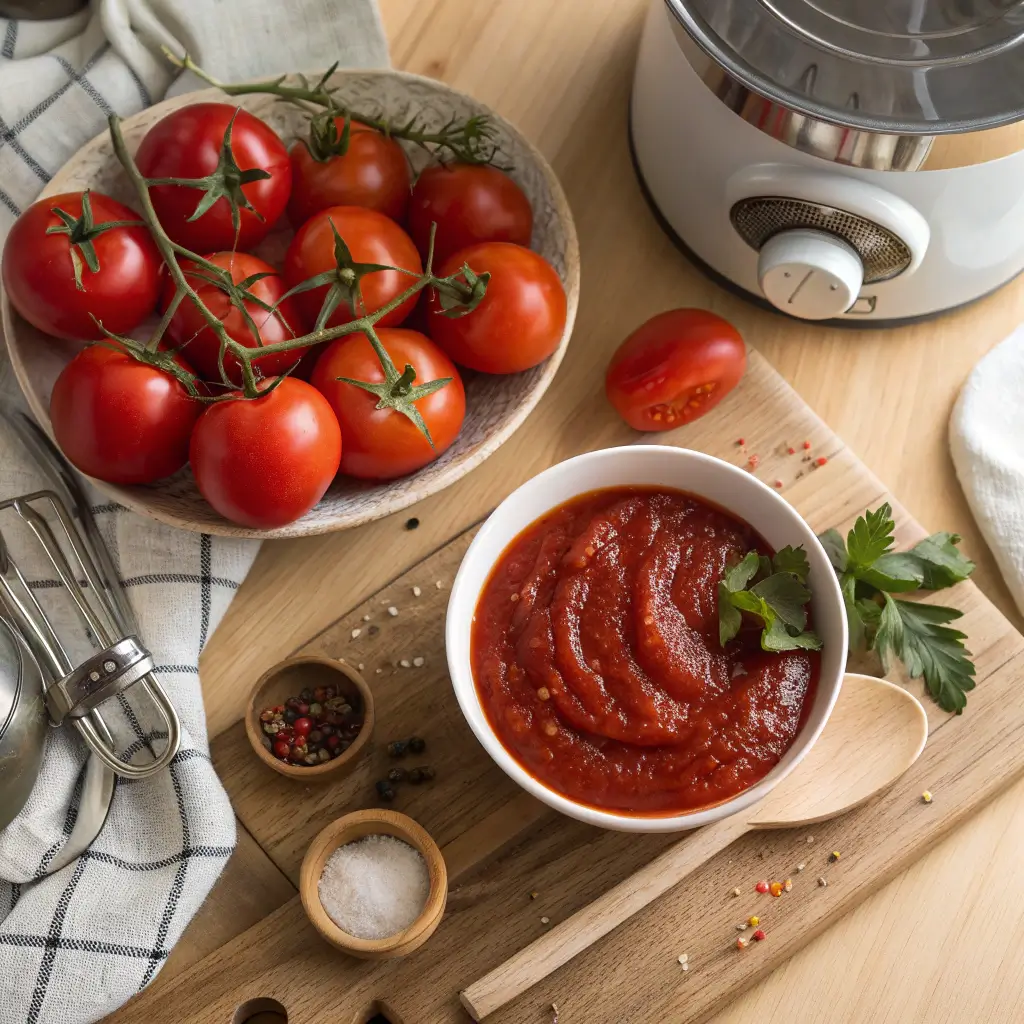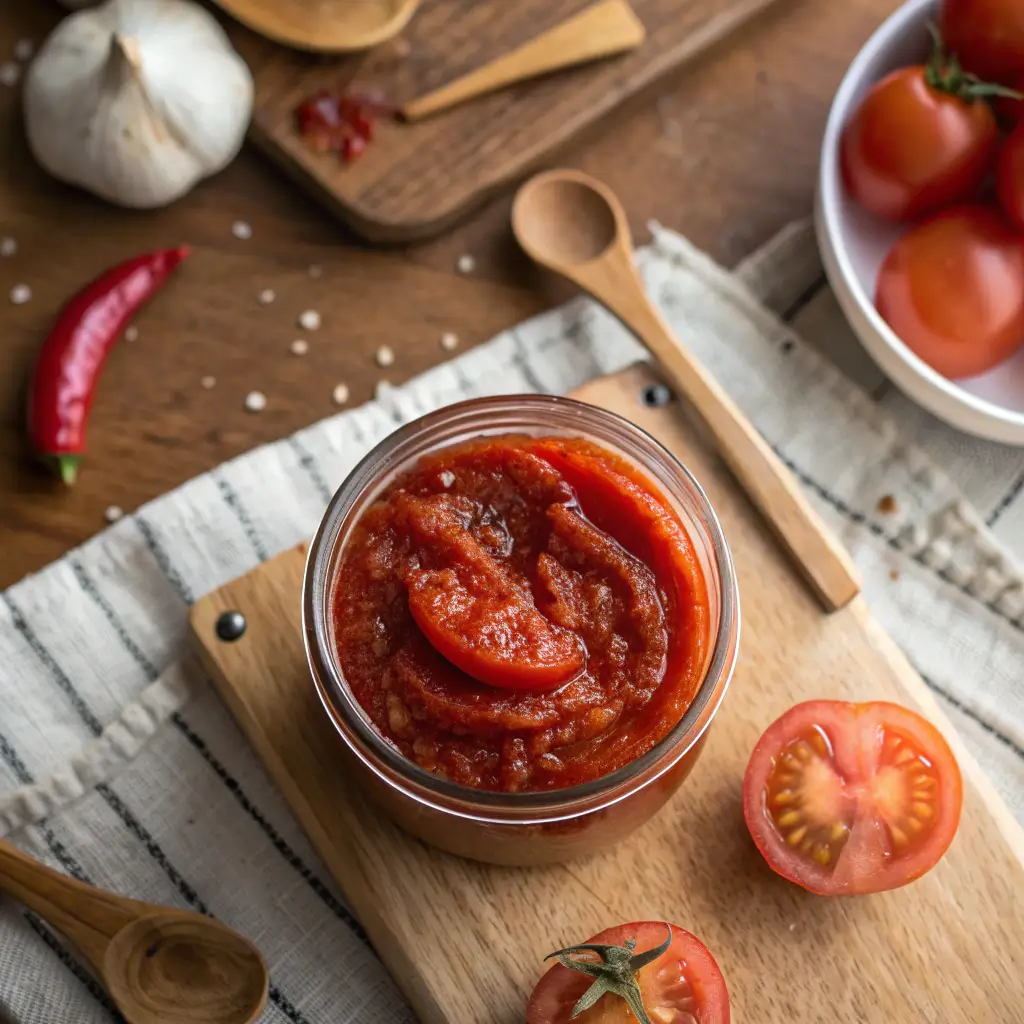Homemade Ketchup: Fresh, Flavorful, and Naturally Sweetened
Introduction
There’s something uniquely satisfying about making your own condiments, and Homemade Ketchup is no exception. Rich, tangy, and perfectly balanced between sweet and savory, this ketchup elevates burgers, fries, sandwiches, and even homemade meatballs. Unlike store-bought versions, homemade ketchup is free from preservatives and artificial flavors, giving you full control over taste, sweetness, and texture.
What makes this recipe special is its simplicity combined with the depth of flavor. Using ripe tomatoes, vinegar, and a blend of spices, you can create a ketchup that is both familiar and customizable. You can make it sweeter, spicier, or smokier depending on your preferences, making it the perfect addition to any homemade meal.
Whether you’re a home cook looking to reduce processed foods or simply want to enjoy the fresh taste of tomato-based condiments, this Homemade Ketchup is a versatile, crowd-pleasing recipe that’s surprisingly easy to prepare.

A Brief Background
Ketchup, originally called “catsup,” has roots in Southeast Asia, where fermented fish sauces were common. It evolved in the 18th and 19th centuries into the tomato-based condiment we recognize today, particularly popular in the United States and Europe.
Homemade ketchup allows cooks to return to the original principle of fresh, simple ingredients, emphasizing flavor rather than additives. By making it yourself, you control sugar levels, acidity, and seasoning, resulting in a vibrant, fresh ketchup that tastes miles away from the processed kind.
Fun fact: Traditional ketchup recipes often included anchovies, mushrooms, or walnuts before tomatoes became the standard base. Today’s homemade versions celebrate the tomato as the star ingredient.
Why You’ll Love This Recipe
- Fresh & Natural: Free from preservatives, artificial colors, or additives.
- Customizable Flavor: Adjust sweetness, acidity, and spices to taste.
- Versatile: Perfect for fries, burgers, meatballs, or as a base for sauces.
- Easy to Make: Requires simple ingredients and minimal cooking skills.
- Long Shelf Life: Keeps in the fridge for several weeks when stored properly.
Ingredients & Equipment
Ingredients:
- 2 lbs (900 g) ripe tomatoes, chopped
- 1 small onion, finely chopped
- 2 cloves garlic, minced
- 1/2 cup (120 ml) apple cider vinegar or white vinegar
- 1/4 cup (50 g) brown sugar (adjust to taste)
- 1 tsp salt
- 1/4 tsp ground allspice
- 1/4 tsp ground cloves
- 1/2 tsp ground black pepper
- 1/4 tsp smoked paprika (optional for depth)
- 1–2 tbsp tomato paste (optional, for thicker consistency)
Equipment Needed:
- Large saucepan or pot
- Wooden spoon or silicone spatula
- Blender or immersion blender
- Fine-mesh strainer or sieve
- Measuring cups and spoons
- Airtight bottles or jars for storage
Pro Tips:
- Use the ripest, freshest tomatoes for maximum flavor.
- Adjust vinegar and sugar to your taste preference; some like it tangier or sweeter.
- Simmer slowly to allow flavors to meld and thicken naturally.
Step-by-Step Instructions
1. Sauté Aromatics
- Heat a tablespoon of olive oil in a large saucepan over medium heat.
- Add chopped onion and garlic; sauté for 3–4 minutes until softened and fragrant.
2. Add Tomatoes and Spices
- Stir in chopped tomatoes, brown sugar, salt, black pepper, allspice, cloves, and smoked paprika.
- Bring the mixture to a simmer over medium heat.
3. Simmer & Reduce
- Reduce heat to low and let the mixture simmer gently for 30–40 minutes.
- Stir occasionally to prevent sticking and ensure even cooking.
- Simmer until tomatoes break down and the mixture thickens.
4. Blend & Strain
- Remove from heat and let cool slightly.
- Blend using an immersion blender or transfer to a regular blender until smooth.
- Optional: Pass the blended mixture through a fine-mesh strainer for ultra-smooth ketchup.
5. Adjust Consistency & Flavor
- If too thin, return to the pot and simmer a few more minutes, stirring frequently.
- Taste and adjust salt, sugar, or vinegar as desired.
6. Bottle & Store
- Pour finished ketchup into sterilized jars or airtight bottles.
- Cool to room temperature, then refrigerate.
- Keeps for up to 3–4 weeks in the fridge.
Visual Cue: The ketchup should have a rich, deep red color with a smooth, velvety texture and a glossy sheen.
Expert Tips & Troubleshooting
- Too Sweet or Too Tangy: Adjust sugar or vinegar gradually to balance flavors.
- To Thin: Simmer longer or add tomato paste for thickness.
- Too Thick: Add a small splash of water or vinegar while blending.
- Flavor Depth: Toast spices lightly before adding to enhance aroma.
- Make Ahead: Can be prepared in bulk and frozen in ice cube trays for easy portioning.
Variations & Customizations
- Spicy Ketchup: Add a pinch of cayenne pepper or smoked chili powder.
- Garlic Lover’s Ketchup: Increase garlic for a bolder flavor.
- Smoky Ketchup: Use smoked paprika and a dash of liquid smoke for a BBQ twist.
- Honey-Sweetened: Substitute brown sugar with honey or maple syrup.
- Herbal Ketchup: Add fresh herbs like basil, oregano, or thyme for unique flavors.
Serving & Presentation Ideas
- Serve alongside fries, roasted vegetables, burgers, or meatballs.
- Use as a base for homemade barbecue sauces, dipping sauces, or marinades.
- Drizzle over roasted potatoes or grilled vegetables for a flavor boost.
- Store in clear bottles or jars and label for gifting or pantry display.
Storage & Make-Ahead Tips
- Refrigeration: Keeps up to 3–4 weeks in airtight containers.
- Freezing: Freeze in small portions (ice cube trays work well) for 2–3 months.
- Meal Prep: Make a large batch in advance for weekly use; portion and store as needed.
- Sterilization: Boil jars or bottles before filling to extend shelf life.

Frequently Asked Questions
Can I use canned tomatoes instead of fresh?
Yes, use a 28-oz (800 g) can of whole peeled or crushed tomatoes; adjust seasoning to taste.
Can this ketchup be made sugar-free?
Yes, use a sugar substitute like erythritol or stevia, but adjust amounts gradually to taste.
Is it safe to store at room temperature?
Refrigeration is recommended to maintain freshness and prevent spoilage.
Can I make it in a slow cooker?
Yes, combine ingredients in a slow cooker on low for 6–8 hours, then blend and strain.
Conclusion
Homemade Ketchup is a simple, flavorful, and versatile condiment that elevates any meal. With ripe tomatoes, aromatic spices, and balanced sweetness, it’s fresh, natural, and completely customizable. Easy to make, preservative-free, and endlessly adaptable, this ketchup is a pantry staple every home cook should try.
Enjoy it with fries, burgers, sandwiches, or even as a base for sauces and dips. Once you try homemade ketchup, you’ll never go back to store-bought!
